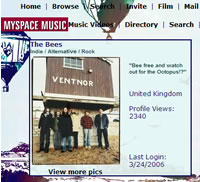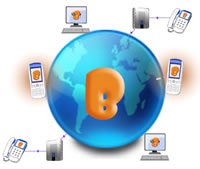 The “wireless tag” business isn’t just for tracking prisoners out on probation: it’s also for tagging holidaymakers and train travellers.
The “wireless tag” business isn’t just for tracking prisoners out on probation: it’s also for tagging holidaymakers and train travellers.
So the news that you can hack a computer system by embedding a virus into an RFID tag wasn’t welcome in RFID circles, and the news that people at Great Wolf Resorts are tagging themselves on purpose, was, very welcome, indeed.
The problem with RFID tags is unlikely to be hacking. The exploit, unveiled by Dutch researchers, worked. Researchers at the science faculty of the Free University of Amsterdam put unexpected data into a tag, which caused a buffer over-run when the system read it.
The RFID industry responded with some optimistic explanations of why it won’t work in real life, including the suggestion that “some tags aren’t rewriteable, so it can’t happen” and (more impressively) “a well designed system would trap that hack.”
The idea that an RFID scanning system would be safe if it expected only permanent tags, is exactly the problem that the Dutch researchers were exposing, of course. The true tag may be read-only; but there’s nothing to stop a hacker producing a phoney tag that matches the signature of the real one. And the problem is exactly the expectation of the system designer. A complacent designer says: “There’s no way these tags can compromise the system, therefore we don’t have to set checks” while the competent designer says: “Who knows what random data might get in? – let’s design this system to be secure!”
 Now that the theoretical insecurity is exposed, says AIM Global (the industry body that promotes RFID), systems will be secure. That sounds right.
Now that the theoretical insecurity is exposed, says AIM Global (the industry body that promotes RFID), systems will be secure. That sounds right.
But the problem with RFID isn’t what most people think. All sorts of scare stories have been printed, based on the idea that if you have an RFID tag, someone can track you as you move around the city.
This story comes from the way the tags work. They have no power, these tags; instead, they are activated by a coil, picking up power from the activator. Most people in London will be familiar with these: the entrance to every Tube station now has the yellow Oyster “touch in, touch out” sensor, which activates the tag in your card, and updates it.
The theory is that the tag will only get enough power to start transmitting if it is within a couple of centimetres of the activator. However, it’s been shown that you can use a focused beam to trigger the tag from a considerable distance – several metres, for sure, and perhaps several dozen metres.
Equally, you can read them from further away than the spec suggests. All you need is a particularly sensitive receiver.
 The risk to civil liberties may be imaginary, as you can quickly see from the trouble prison officials are having with tagging of criminals. Putting a tag on someone’s wrist or ankle is easy enough, but reading it requires two essential steps. First, the tag has to be there (people have been merrily removing their tags so as to go out to the pub after curfew!) and next, it has to be unshielded. A simple aluminium foil shield around the tag, and it becomes invisible.
The risk to civil liberties may be imaginary, as you can quickly see from the trouble prison officials are having with tagging of criminals. Putting a tag on someone’s wrist or ankle is easy enough, but reading it requires two essential steps. First, the tag has to be there (people have been merrily removing their tags so as to go out to the pub after curfew!) and next, it has to be unshielded. A simple aluminium foil shield around the tag, and it becomes invisible.
The Grand Wolf tags work on the assumption that people want to be tagged in and out of the holiday centre, so that they don’t have to be searched. Try using the same technology for tracking a prisoner on probation, and the system quickly falls apart.
 What would work, would be a system which constantly monitored where the tag was, and was embedded into the skin (as with Professor Kevin “Cyborg” Warwick of Reading University, who wore a dog tag for a week) or into a tooth – so that if the user shielded it, it would instantly vanish from the map, causing an alarm. It would work – but it would require thousands and thousands of activators, all working at long distance, everywhere the user was likely to go.
What would work, would be a system which constantly monitored where the tag was, and was embedded into the skin (as with Professor Kevin “Cyborg” Warwick of Reading University, who wore a dog tag for a week) or into a tooth – so that if the user shielded it, it would instantly vanish from the map, causing an alarm. It would work – but it would require thousands and thousands of activators, all working at long distance, everywhere the user was likely to go.
 The Oyster system for London Underground is to be extended so that it works on UK railways generally. That will show where the real problems are – and as any Oyster user will tell you, they are already baffling Transport For London. Travellers find that their cards beep at them as they go through the gates, saying “Seek Assistance!” – but when they present them at the ticket office, the staff say “Nothing wrong, go away.”
The Oyster system for London Underground is to be extended so that it works on UK railways generally. That will show where the real problems are – and as any Oyster user will tell you, they are already baffling Transport For London. Travellers find that their cards beep at them as they go through the gates, saying “Seek Assistance!” – but when they present them at the ticket office, the staff say “Nothing wrong, go away.”
Clearly, there is something wrong. Clearly, the complexity of the system is too great for unskilled staff to diagnose faults. That’s where RFID opponents ought to focus their concerns – not on imaginary Sci-Fi scenarios with Big Brother spies and dog-tags under the skin, but on simple systems management.
Usability is far harder to get right than people think.
 If the market for flash memory-based MP3 players wasn’t overcrowded enough, big name electronics company Hitachi have decided to steam in with a collection of their own.
If the market for flash memory-based MP3 players wasn’t overcrowded enough, big name electronics company Hitachi have decided to steam in with a collection of their own.  Wrapping up the trio is the HMP-S3, housed in a slightly squashed square form factor and available in yellow or white (you could never accuse the Hitachi designers of being too ambitious with this range).
Wrapping up the trio is the HMP-S3, housed in a slightly squashed square form factor and available in yellow or white (you could never accuse the Hitachi designers of being too ambitious with this range).  It is being reported that MySpace-owner, News International, is looking to expand its presence in Europe with its focus being London.
It is being reported that MySpace-owner, News International, is looking to expand its presence in Europe with its focus being London. Importantly it also has social/network effects built it. This works both for the creators, as they grow their links to their friends – real and imagined; but importantly for MySpace’s income, the network effect for browsers is huge. As a browser looks at the original site, they split off in a myriad of different directions as they distract themselves, exploring the music taste and hobbies of linked friends.
Importantly it also has social/network effects built it. This works both for the creators, as they grow their links to their friends – real and imagined; but importantly for MySpace’s income, the network effect for browsers is huge. As a browser looks at the original site, they split off in a myriad of different directions as they distract themselves, exploring the music taste and hobbies of linked friends.  It’s expanded beyond this now and has now reached the point where record companies feel bands _must_ have their own presence on MySpace, even if they’ve got their own Web presence – witness sons of Ventnor,
It’s expanded beyond this now and has now reached the point where record companies feel bands _must_ have their own presence on MySpace, even if they’ve got their own Web presence – witness sons of Ventnor,  With the media footprint that News International has, it’s highly likely that they’re going to be able to make best value from what appears to be a considerable purchase price. Already there’s been reports their
With the media footprint that News International has, it’s highly likely that they’re going to be able to make best value from what appears to be a considerable purchase price. Already there’s been reports their  Do NOT read this report, if you’re fond of crosswords. Don’t say I didn’t warn you.
Do NOT read this report, if you’re fond of crosswords. Don’t say I didn’t warn you.  I was being pig-headed. I only had one guess left, and all I knew besides that was that the letter ‘c’ was not one of those used. And if I got it wrong, it was “game over” while if I got it right, it was a thousand points onto the total.
I was being pig-headed. I only had one guess left, and all I knew besides that was that the letter ‘c’ was not one of those used. And if I got it wrong, it was “game over” while if I got it right, it was a thousand points onto the total.  I’ll be interested to see if this means I never do crosswords again, or whether I now do them more frequently. Amo’s is bad enough, but
I’ll be interested to see if this means I never do crosswords again, or whether I now do them more frequently. Amo’s is bad enough, but  The “wireless tag” business isn’t just for tracking prisoners out on probation: it’s also for tagging holidaymakers and train travellers.
The “wireless tag” business isn’t just for tracking prisoners out on probation: it’s also for tagging holidaymakers and train travellers. Now that the theoretical insecurity is exposed, says AIM Global (the industry body that promotes RFID), systems will be secure. That sounds right.
Now that the theoretical insecurity is exposed, says AIM Global (the industry body that promotes RFID), systems will be secure. That sounds right.  The risk to civil liberties may be imaginary, as you can quickly see from the trouble prison officials are having with tagging of criminals. Putting a tag on someone’s wrist or ankle is easy enough, but reading it requires two essential steps. First, the tag has to be there (people have been merrily removing their tags so as to go out to the pub after curfew!) and next, it has to be unshielded. A simple aluminium foil shield around the tag, and it becomes invisible.
The risk to civil liberties may be imaginary, as you can quickly see from the trouble prison officials are having with tagging of criminals. Putting a tag on someone’s wrist or ankle is easy enough, but reading it requires two essential steps. First, the tag has to be there (people have been merrily removing their tags so as to go out to the pub after curfew!) and next, it has to be unshielded. A simple aluminium foil shield around the tag, and it becomes invisible.  What would work, would be a system which constantly monitored where the tag was, and was embedded into the skin (as with Professor Kevin “Cyborg” Warwick of Reading University, who wore a dog tag for a week) or into a
What would work, would be a system which constantly monitored where the tag was, and was embedded into the skin (as with Professor Kevin “Cyborg” Warwick of Reading University, who wore a dog tag for a week) or into a  The Oyster system for London Underground is to be extended so that it works on UK railways generally. That will show where the real problems are – and as any Oyster user will tell you, they are already baffling Transport For London. Travellers find that their cards beep at them as they go through the gates, saying “Seek Assistance!” – but when they present them at the ticket office, the staff say “Nothing wrong, go away.”
The Oyster system for London Underground is to be extended so that it works on UK railways generally. That will show where the real problems are – and as any Oyster user will tell you, they are already baffling Transport For London. Travellers find that their cards beep at them as they go through the gates, saying “Seek Assistance!” – but when they present them at the ticket office, the staff say “Nothing wrong, go away.”  LG have announced a unique new phone, the LG-SD910, featuring what the Korean manufacturing giants are describing as a ‘Duo Slide Design.’
LG have announced a unique new phone, the LG-SD910, featuring what the Korean manufacturing giants are describing as a ‘Duo Slide Design.’  Looking a bit of a moody number in its all-black skin and glowing red buttons, the LG-SD910 sports a large 260k colour QVGA* TFT LCD screen (*that’s 320 x 240 pixels in English).
Looking a bit of a moody number in its all-black skin and glowing red buttons, the LG-SD910 sports a large 260k colour QVGA* TFT LCD screen (*that’s 320 x 240 pixels in English).  Despite its unusual construction and feature set, when all the slidey bits are tucked in the LG-SD910’s a surprisingly compact gizmo, measuring a pocketable 87 x 44 x 23 mm and weighing in at 90g.
Despite its unusual construction and feature set, when all the slidey bits are tucked in the LG-SD910’s a surprisingly compact gizmo, measuring a pocketable 87 x 44 x 23 mm and weighing in at 90g.  When you actually talk to John Bunt, it’s me-groups-legal-pitfalls-with-postingshard to imagine him getting so angry about a Usenet group flame session, as to take the other parties to court. But he did. He also took their ISPs to court for carrying their libels.
When you actually talk to John Bunt, it’s me-groups-legal-pitfalls-with-postingshard to imagine him getting so angry about a Usenet group flame session, as to take the other parties to court. But he did. He also took their ISPs to court for carrying their libels.  That dates back to a Noble Lord of the 19th century, who won a libel action against a book, causing the publisher to be convicted. Some years later, he found a second hand copy of that book in a second hand book shop, and sued them – and won. This meant that people sued WH Smiths – not because they disliked the bookseller, but because Private Eye was poor, and WH Smith had plenty of money.
That dates back to a Noble Lord of the 19th century, who won a libel action against a book, causing the publisher to be convicted. Some years later, he found a second hand copy of that book in a second hand book shop, and sued them – and won. This meant that people sued WH Smiths – not because they disliked the bookseller, but because Private Eye was poor, and WH Smith had plenty of money.  This sort of case seems to be on the increase. “Anyone with web access and a quick temper can find themselves facing a lawsuit,” commented
This sort of case seems to be on the increase. “Anyone with web access and a quick temper can find themselves facing a lawsuit,” commented  “Today’s state of the art in spam control solutions is far ahead of where it was, say, two years ago. Improved spam filters being available to more people — plus laws that allow the citizenry to penalise spammers — will cause the scourge of email spam to wither and die.”
“Today’s state of the art in spam control solutions is far ahead of where it was, say, two years ago. Improved spam filters being available to more people — plus laws that allow the citizenry to penalise spammers — will cause the scourge of email spam to wither and die.”  The Goodmail idea is simple enough; you create a world in which only mail from known sources gets through. You and I, as mail users, tell our email system that if we don’t have someone’s name in the address book, then it’s spam. And our email system then says: “I’ve been given money to let this person through” and we say: “Well, I trust my email system.”
The Goodmail idea is simple enough; you create a world in which only mail from known sources gets through. You and I, as mail users, tell our email system that if we don’t have someone’s name in the address book, then it’s spam. And our email system then says: “I’ve been given money to let this person through” and we say: “Well, I trust my email system.”  A new service, Barablu, launches today claiming to offer free voice calls and text messages between mobile phones.
A new service, Barablu, launches today claiming to offer free voice calls and text messages between mobile phones. It’s as clear as the screen on your PSP that mobile phone operators aren’t very keen on ideas like this. Many commentators have claimed that the operators have gone a long way to trying to block the development and sale of WiFi-capable mobile phones – as the operators are terrified that it will erode the price of calls from ‘quite a lot’ per minute, to zero.
It’s as clear as the screen on your PSP that mobile phone operators aren’t very keen on ideas like this. Many commentators have claimed that the operators have gone a long way to trying to block the development and sale of WiFi-capable mobile phones – as the operators are terrified that it will erode the price of calls from ‘quite a lot’ per minute, to zero.  Barablu does appear to have something unique here – at least currently. The difficulty they’re going to hit is the same for anyone trying to build a community of users and provide this type of service -it’s all about the number of people you can attract on to it. If people find their friends aren’t on it, or their said friends already have a similar service – the software will get unloaded and they’ll stop using it.
Barablu does appear to have something unique here – at least currently. The difficulty they’re going to hit is the same for anyone trying to build a community of users and provide this type of service -it’s all about the number of people you can attract on to it. If people find their friends aren’t on it, or their said friends already have a similar service – the software will get unloaded and they’ll stop using it.  Things are hotting up in the US VoIP market as Yahoo announces their low cost Messenger with Voice service, letting users make phone calls through the company’s instant messaging software.
Things are hotting up in the US VoIP market as Yahoo announces their low cost Messenger with Voice service, letting users make phone calls through the company’s instant messaging software.  The Phone In service – which lets customers to receive calls on their computers from regular and mobile phones – is priced at $2.99 a month, or $29.90 (~£17, ~€25) a year, compared to Skype’s €30 yearly charge.
The Phone In service – which lets customers to receive calls on their computers from regular and mobile phones – is priced at $2.99 a month, or $29.90 (~£17, ~€25) a year, compared to Skype’s €30 yearly charge.  Yahoo are upbeat about prospects for their new service after trials in the initial five countries proved more successful than anticipated, especially in France.
Yahoo are upbeat about prospects for their new service after trials in the initial five countries proved more successful than anticipated, especially in France.